使用Scrapy 爬取“http://tuijian.hao123.com/”网页中左上角“娱乐”、“体育”、“财经”、“科技”、历史等名称和URL
发布时间:2024年01月20日
一、网页信息
 二、检查网页,找出目标内容
二、检查网页,找出目标内容

三、根据网页格式写正常爬虫代码
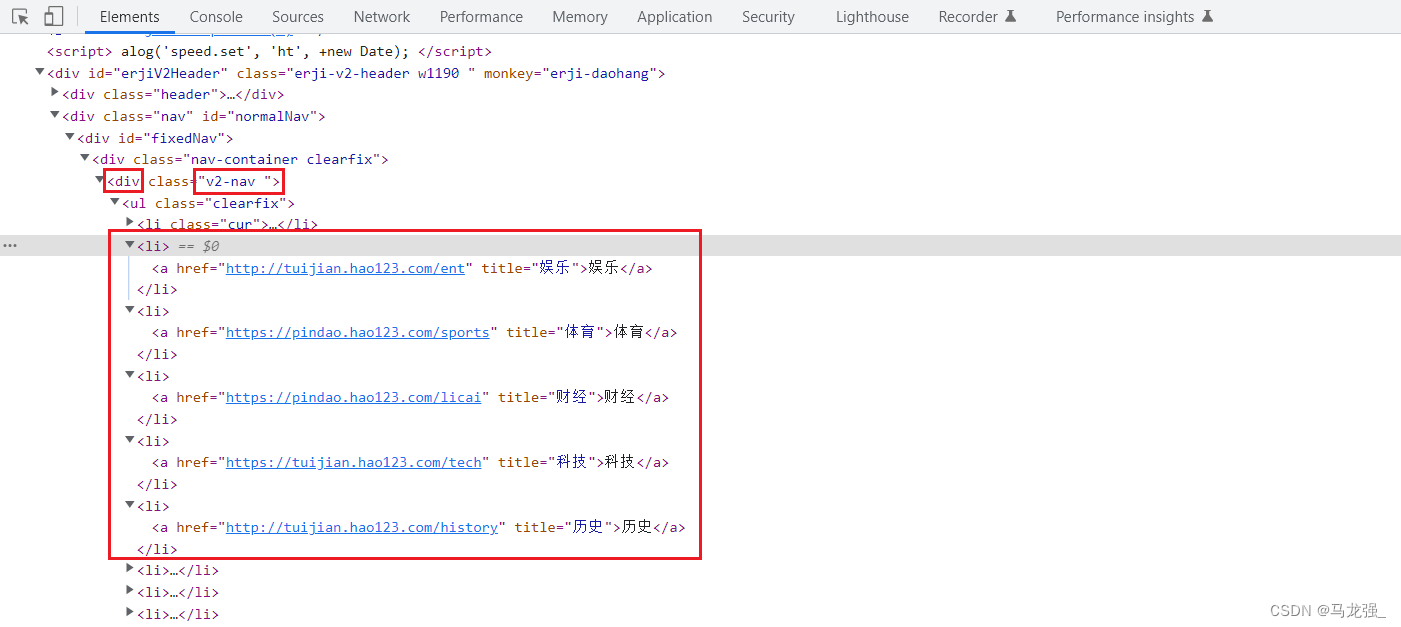
from bs4 import BeautifulSoup
import requests
headers = {
'User-Agent': 'Mozilla/5.0 (Windows NT 10.0; Win64; x64) AppleWebKit/537.36 (KHTML, like Gecko) Chrome/107.0.0.0 Safari/537.36',
}
url = 'http://tuijian.hao123.com/'
response = requests.get(url=url,headers=headers)
response.encoding='utf-8'
soup = BeautifulSoup(response.text, 'html.parser')
list_div = soup.find('div', class_='v2-nav')
ul_tags = list_div.find_all('ul')[0]
li_tags = ul_tags.find_all('li')
for li in li_tags:
a_tag = li.find('a')
if a_tag:
title = a_tag.text
href = a_tag['href']
if title in ["娱乐", "体育", "财经", "科技", "历史"]:
print(f"{title}: {href}")四、创建Scrapy项目haohao
1.进入相关目录中,执行:scrapy startproject haohao
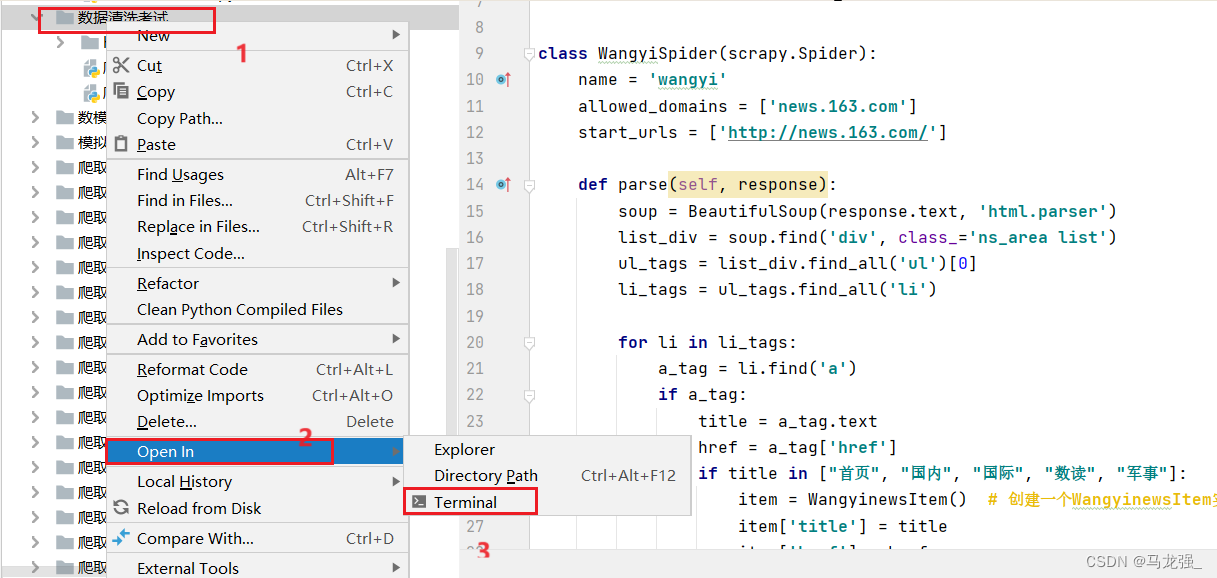

2.创建结果

五、创建爬虫项目haotuijian.py
1.进入相关目录中,执行:scrapy genspider?haotuijian?http://tuijian.hao123.com/


2.执行结果,目录中出现haotuijian.py文件

六、写爬虫代码和配置相关文件
1.haotuijian.py文件代码
import scrapy
from bs4 import BeautifulSoup
from ..items import HaohaoItem
class HaotuijianSpider(scrapy.Spider):
name = 'haotuijian'
allowed_domains = ['tuijian.hao123.com']
start_urls = ['http://tuijian.hao123.com/']
def parse(self, response):
soup = BeautifulSoup(response.text, 'html.parser')
list_div = soup.find('div', class_='v2-nav')
ul_tags = list_div.find_all('ul')[0]
li_tags = ul_tags.find_all('li')
for li in li_tags:
a_tag = li.find('a')
if a_tag:
title = a_tag.text
href = a_tag['href']
if title in ["娱乐", "体育", "财经", "科技", "历史"]:
item = HaohaoItem() # 创建一个HaohaoItem实例来传输保存数据
item['title'] = title
item['href'] = href
yield item2.items.py文件代码
# Define here the models for your scraped items
#
# See documentation in:
# https://docs.scrapy.org/en/latest/topics/items.html
import scrapy
class HaohaoItem(scrapy.Item):
# define the fields for your item here like:
# name = scrapy.Field()
title = scrapy.Field()
href = scrapy.Field()3.pipelines.py文件代码(保存数据到Mongodb、Mysql、Excel中)
# Define your item pipelines here
#
# Don't forget to add your pipeline to the ITEM_PIPELINES setting
# See: https://docs.scrapy.org/en/latest/topics/item-pipeline.html
# useful for handling different item types with a single interface
from itemadapter import ItemAdapter
from pymongo import MongoClient
import openpyxl
import pymysql
#保存到mongodb中
class HaohaoPipeline:
def __init__(self):
self.client = MongoClient('mongodb://localhost:27017/')
self.db = self.client['qiangzi']
self.collection = self.db['hao123']
self.data = []
def close_spider(self, spider):
if len(self.data) > 0:
self._write_to_db()
self.client.close()
def process_item(self, item, spider):
self.data.append({
'title': item['title'],
'href': item['href'],
})
if len(self.data) == 100:
self._write_to_db()
self.data.clear()
return item
def _write_to_db(self):
self.collection.insert_many(self.data)
self.data.clear()
#保存到mysql中
class MysqlPipeline:
def __init__(self):
self.conn = pymysql.connect(
host='localhost',
port=3306,
user='root',
password='789456MLq',
db='pachong',
charset='utf8mb4'
)
self.cursor = self.conn.cursor()
self.data = []
def close_spider(self,spider):
if len(self.data) > 0:
self._writer_to_db()
self.conn.close()
def process_item(self, item, spider):
self.data.append(
(item['title'],item['href'])
)
if len(self.data) == 100:
self._writer_to_db()
self.data.clear()
return item
def _writer_to_db(self):
self.cursor.executemany(
'insert into haohao (title,href)'
'values (%s,%s)',
self.data
)
self.conn.commit()
#保存到excel中
class ExcelPipeline:
def __init__(self):
self.wb = openpyxl.Workbook()
self.ws = self.wb.active
self.ws.title = 'haohao'
self.ws.append(('title','href'))
def open_spider(self,spider):
pass
def close_spider(self,spider):
self.wb.save('haohao.xlsx')
def process_item(self,item,spider):
self.ws.append(
(item['title'], item['href'])
)
return item4.settings.py文件配置



七、运行代码
1.进入相关目录,执行:scrapy crawl haotuijian

2.执行过程
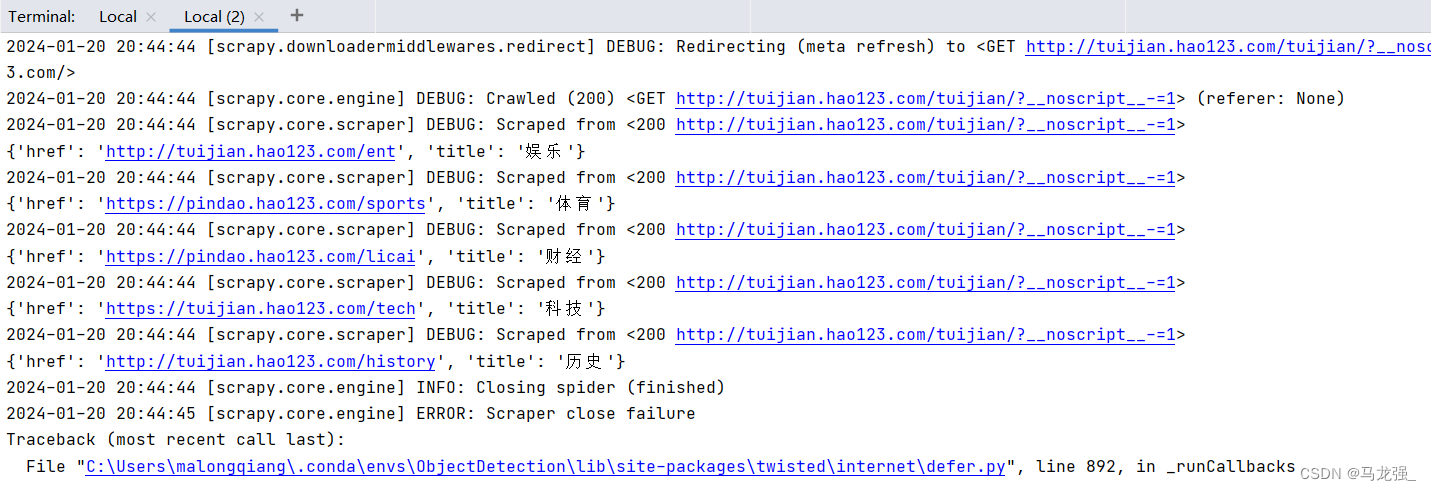
3.执行结果
(1) haohao.excel


(2) Mysql:haohao? (需提前创建表)

(3)Mongodb: hao123
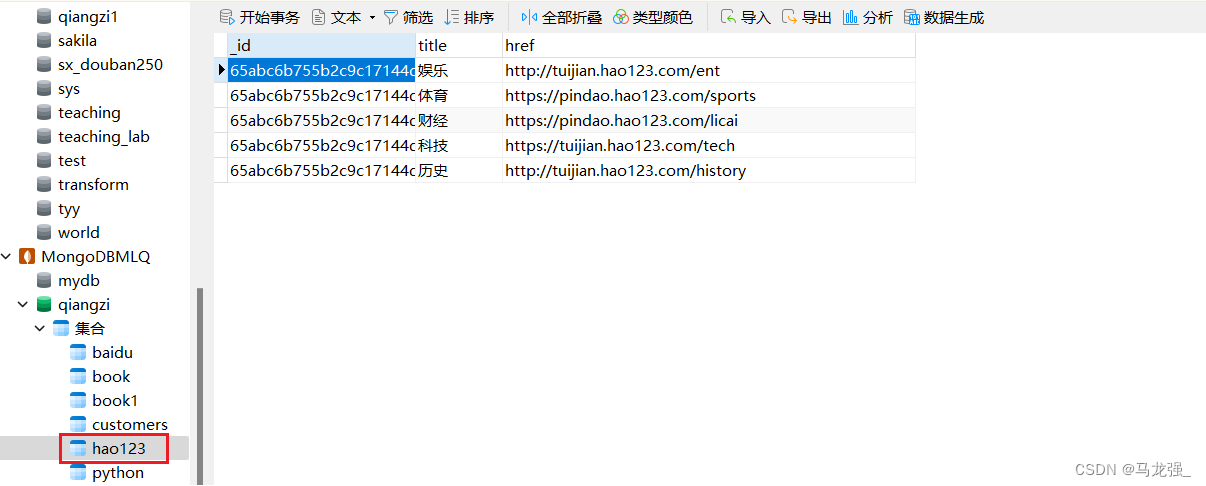
八、知识补充
1.创建main.py文件,并编写代码

2.直接运行main.py文件
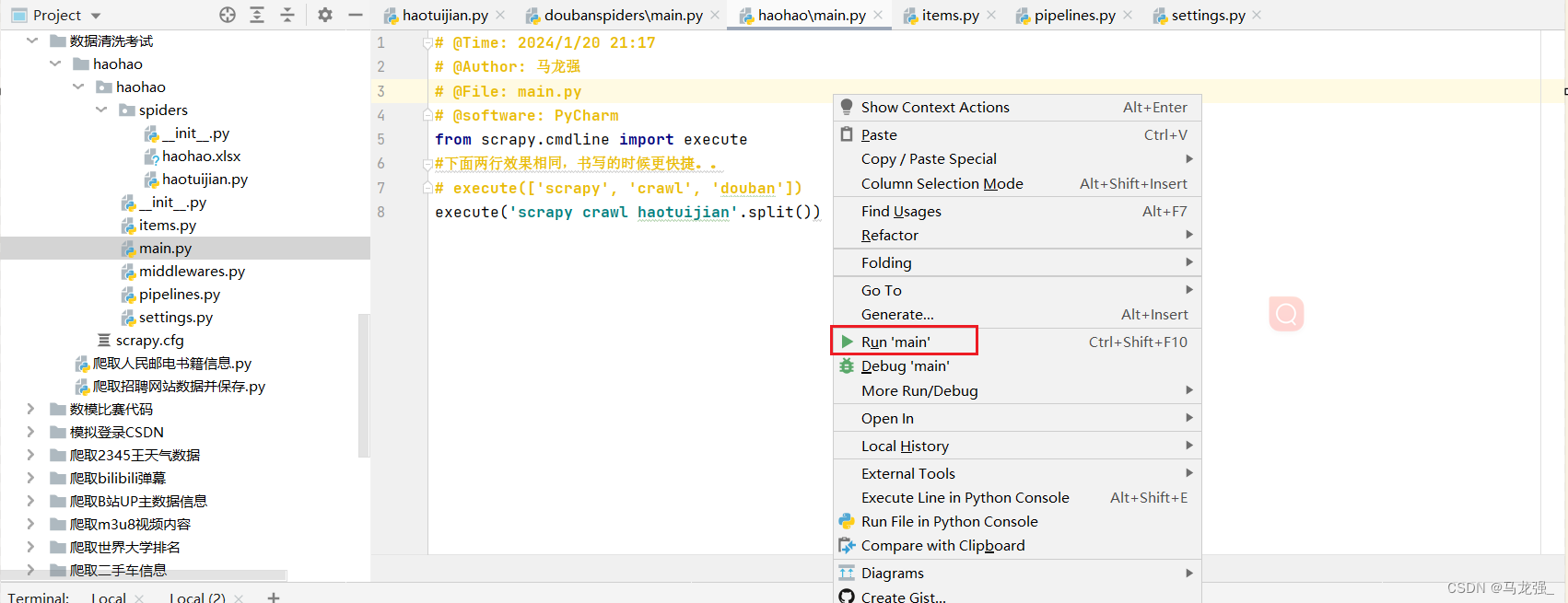
3.运行结果与使用指令运行结果相同(只不过运行过程变成了红色,但可以像普通python代码一样可以随时暂停)
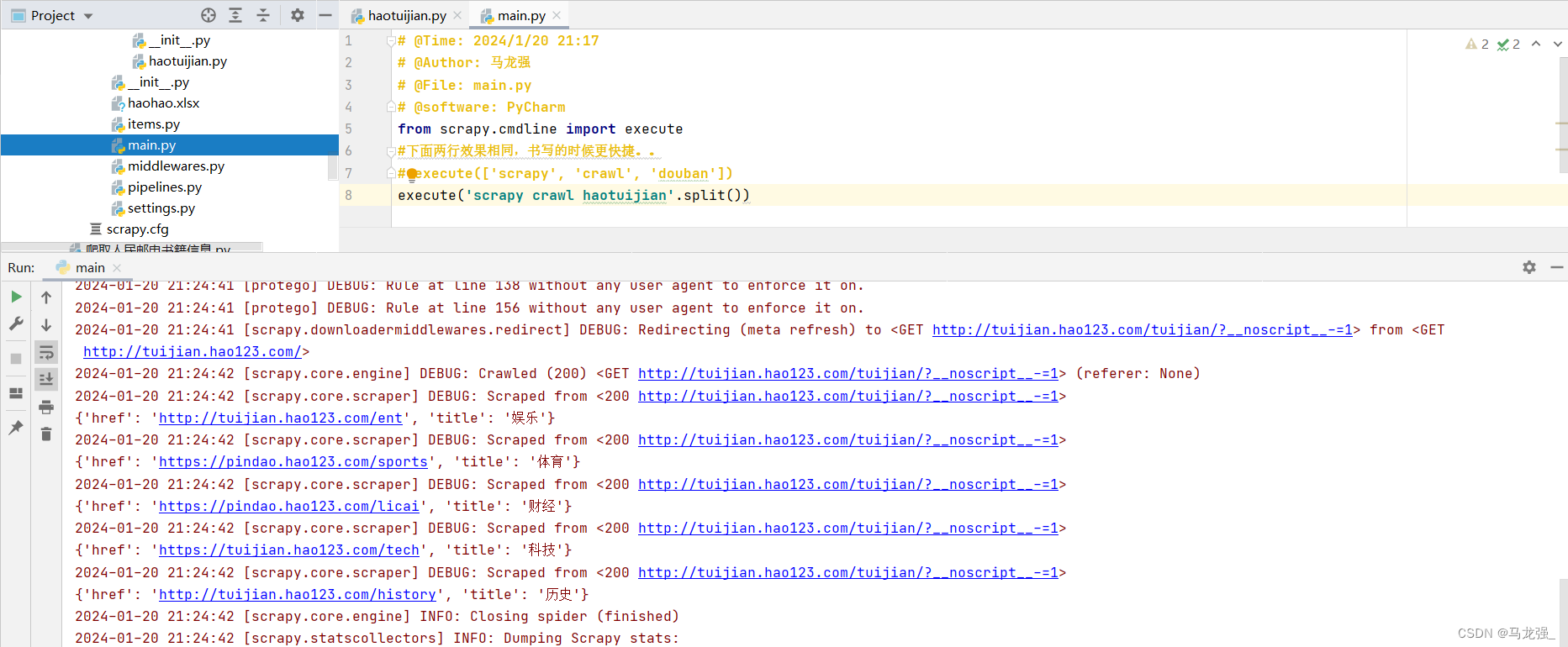
文章来源:https://blog.csdn.net/m0_74972727/article/details/135720787
本文来自互联网用户投稿,该文观点仅代表作者本人,不代表本站立场。本站仅提供信息存储空间服务,不拥有所有权,不承担相关法律责任。 如若内容造成侵权/违法违规/事实不符,请联系我的编程经验分享网邮箱:chenni525@qq.com进行投诉反馈,一经查实,立即删除!
本文来自互联网用户投稿,该文观点仅代表作者本人,不代表本站立场。本站仅提供信息存储空间服务,不拥有所有权,不承担相关法律责任。 如若内容造成侵权/违法违规/事实不符,请联系我的编程经验分享网邮箱:chenni525@qq.com进行投诉反馈,一经查实,立即删除!
最新文章
- Python教程
- 深入理解 MySQL 中的 HAVING 关键字和聚合函数
- Qt之QChar编码(1)
- MyBatis入门基础篇
- 用Python脚本实现FFmpeg批量转换
- 2023年12月Scratch等级考试(四级)真题试卷
- Angular系列教程之组件
- Flutter实现丝滑的滑动删除、移动排序等-Dismissible控件详解
- Java 深入理解 AQS 和 CAS 原理
- 现代密码学 补充1:两种窃听不可区分实验的区别
- 使用 CompletableFuture 分批处理任务
- Go工程大坑,空切片和nil切片
- 跑酷小游戏
- Redis相关知识点
- OpenCV can’t augment image: 608 x 608